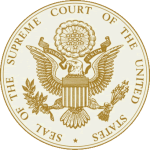- Отрасли: Government
- Number of terms: 836
- Number of blossaries: 0
- Company Profile:
The highest court in the United States. It's the judicial branch of the United States government. The U.S. Supreme Court has the ultimate appellate jurisdiction over all state and federal courts.
The respondent is the party that won in the lower court. His name goes second in the case name. (For example, Al Gore was the respondent in Bush v. Gore. )
Industry:Government
A habeas petition is a request for a court to review the legality of someone’s detention or imprisonment. All federal courts – not just the Supreme Court – can hear habeas petitions, though federal statutes impose significant constraints.
Industry:Government
When the Supreme Court vacates a lower court ruling, it strips that ruling of effect, often in order to send the case back to the lower court for further proceedings.
Industry:Government
When the Court “GVRs,” it “grants certiorari,” “vacates” the decision below, and “remands” a case to the lower court without hearing oral argument or deciding its merits. A GVR order is not accompanied by a written opinion addressing the merits of the case, but the Court usually provides some direction to the lower court by, for example, instructing it to reconsider its decision in light of a recent decision by the Supreme Court.
Industry:Government
The Supreme Court grants certiorari when it decides, at the request of the party that has filed a petition for certiorari, to review the merits of the case. For roughly every 100 petitions for certiorari received by the court, about one petition is granted. (If the Supreme Court denies certiorari in a case, then the lower court decision stands; the decision to deny certiorari does not make precedent. )
Industry:Government
The Court issues a summary reversal when it grants certiorari in a case and overturns the decision below without written briefs or oral argument on the merits. When the Court reaches a judgment this way, it generally issues a per curiam opinion.
Industry:Government
The petitioner is the party asking the Supreme Court to review the case because she lost the dispute in the lower court. Her name goes first in the case name. (For example, George W. Bush was the petitioner in Bush v. Gore. )
Industry:Government
Il parere emesso dal giudice che ha sentito il caso, immediatamente prima che la parte soccombente ha chiesto alla Corte suprema di rivedere il caso (quasi sempre un federale Corte d'appello o un tribunale dello stato di ultima istanza) è conosciuto come il parere qui sotto.
Industry:Government
Il firmatario è il partito chiedendo alla Corte suprema di rivedere il caso perché ha perso la disputa in tribunale di grado inferiore. Il suo nome va primo nel nome del caso. (Ad esempio, Bush fu il firmatario nel Bush v. Gore).
Industry:Government
The thirteen courts of appeals are federal courts that hear appeals – mostly from federal district (i. E. , trial) courts, but also from federal administrative agencies. Of all the cases the Supreme Court hears, the vast majority come from federal courts of appeals. A court of appeals is often referred to by the name or number of its circuit (i. E. , “Ninth Circuit”).
Industry:Government
